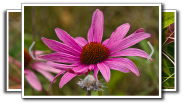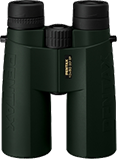scaly bee fly
(Lepidophora lepidocera)
Conservation • Description • Habitat • Ecology • Distribution • Taxonomy • References
|
|
||||||||||||||
Description |
Scaly bee fly is a relatively large, nest parasitizing (kleptoparasitic) fly. It occurs throughout the United States east of the Great Plains, but it is rare above 42° North. It is rare in Minnesota. Adults are active from May through October. They are found in open areas near deciduous woodlands. They feed on flower nectar. The larvae live in the nests of solitary wasps of the families Vespidae and Sphecidae. They eat the provisions that are stored in the nest for the wasp larva. Scaly bee fly is said to resemble bee in color and a robber fly in size and shape. However, they do not sting and they do not bite. Adults are about ⅜″ (10 mm) in length. The body is strongly hunch-backed, somewhat L-shaped when viewed from the side. When measuring both legs of the “L”, they are 7⁄16″ to 13⁄16″ (11.6 to 21.4 mm) in length. The base color is dark brown and there are areas of long pale hairs, long pale scales, and long dark scales. The pale scales are usually pale yellow, sometimes white. The head is slightly narrower than the thorax. There are long spoon-shaped scales on the margins of the plate on the face above the upper lip (clypeus). The antennae are long, much longer than the head. They are densely covered with long flattened scales. The tube-like mouthpart (proboscis) is relatively short, not as long as the antennae. The thorax is densely covered with pale yellow scales except for three longitudinal, bare stripes. The plate on the first segment of the thorax (pronotum) is well developed and prominent. The wings are at least as long as the abdomen. They are dark smoky brown, and there are scales on the upper surface toward the base. Vein M2 is present. Vein R2+3 is not connected by a cross vein to vein R4. The legs are long, slender, and dark brown. The abdomen is long and cylindrical. The first abdominal segment (A1) has long pale-yellow hairs on the front margin and a dense tuft of long pale-yellow hairs on each side. A2, A3, and A5 also have pale yellow tufts on each side. A4 has no yellow hairs. A6, A7, and A8 have long, dark brown scales on each side. |
Size |
Female total length: 9⁄16″ to ¾″ (13.7 to 18.7 mm) Male total length: 7⁄16″ to 13⁄16″ (11.6 to 21.4 mm) |
Similar Species |
Habitat |
Open areas near deciduous woodlands |
Ecology |
Season |
May through October |
Behavior |
|
Life Cycle |
|
Larva Food |
Larvae eat the collected food and/or the larvae of solitary wasps. |
Adult Food |
Flower nectar |
Distribution |
||
|
Sources Lamas, C. J. E. (2013). A Revision of the New World genus Lepidophora Westwood, 1835 (Diptera, Bombyliidae, Ecliminae) with a key to the species. Zootaxa. |
|
| 6/4/2025 | ||
Occurrence |
||
|
||
Taxonomy |
|
Order |
|
Suborder |
Brachycera |
Infraorder |
Orthorrhapha |
Superfamily |
Asiloidea |
Family |
Bombyliidae (bee flies) |
Subfamily |
Bombyliinae / Ecliminae |
Tribe |
Eclimini |
Genus |
Lepidophora |
Subfamily |
|
Subordinate Taxa |
|
|
|
Synonyms |
|
Lepidophora aegeriiformis Ploas aegeriiformis Ploas oegeriformis Toxophora appendiculata Toxophora lepidocera |
|
Common Names |
|
scaly bee fly |
|
References |
Lamas, C. J. E. (2013). A Revision of the New World genus Lepidophora Westwood, 1835 (Diptera, Bombyliidae, Ecliminae) with a key to the species. Zootaxa. |
Glossary
Clypeus
On insects, a hardened plate on the face above the upper lip (labrum).
Proboscis
The tube-like protruding mouthpart(s) of a sucking insect.
Pronotum
The exoskeletal plate on the upper side of the first segment of the thorax of an insect.
Visitor Photos |
||
Share your photo of this insect. |
||
This button not working for you? |
||
Bri Hines-Parrish |
||
 |
 |
|
MinnesotaSeasons.com Photos |
||
|
||
|
||

Slideshows |
|

Visitor Videos |
||
Share your video of this insect. |
||
This button not working for you? |
||
|
Other Videos |
||
BEE FLY Lepidophora lepidocera slow motion hovering |
About
Aug 7, 2019 Lepidophora lepidocera HUMPBACK BEE FLY hovering. Lake Co. FP, IL. 7/24/2019 |
Scaly Bee Fly visits Hempvine flowers |
About
Sep 28, 2022 A Scaly Bee Fly (Lepidophora lepidocera) visits Hempvine (Mikania scandens) flowers at the South Woodway Pond at the Houston Arboretum & Nature Center, in Houston, TX, USA. This was the first time I've come across this kind of fly before. It had a very distinct humpbacked form that I'd never seen before in any insect, and I had no idea what exactly I was looking at. It looked sort of like a bee, but my first thought was it maybe some sort of fly, but then I thought of the Clearwing Moth that I came across a few months back ( • Undescribed Clearwing Moth lays eggs ), and I thought maybe it was something like that. And then I thought maybe it's some other kind of insect entirely? Nope. It's a fly. |

|
Created: 6/4/2025 Last Updated: © MinnesotaSeasons.com. All rights reserved. |


